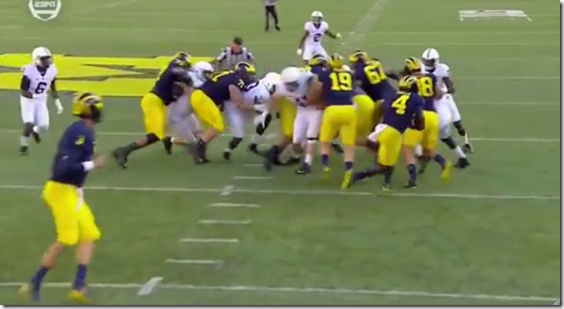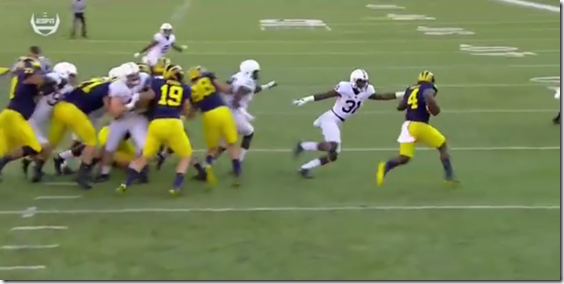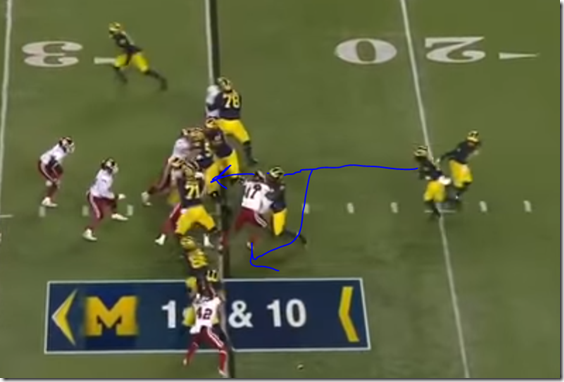[This series is a work-in-progress glossary of football concepts we tend to talk about in these pages. Previously:
Offensive concepts:Run-pass options (RPOs), High-low passing routes, Covered/Ineligible receivers
Blocking: Zone vs Gap, Reach, Kickout, Wham
Defensive concepts:Keeping Contain/Lane Integrity, Force Player, Hybrid Space Player, One-Gap Fronts, Scrape Exchange.
Coverages: Tampa 2, Pattern-Matching, Quarters and how MSU runs it
Special Teams: Spread punt vs NFL-style]
------------------------------------------
This one confused us when Michigan ran it. In the above Poggi was trying to go between Braden and Butt while a middle linebacker got to sit free in a hole. Smith kind of challenged that guy, then bounced outside for a big gain. Brian guessed it was some sort of split zone that Poggi biffed. But after a twitter conversation and a few recent trips through Bo’s old playbooks I theorize it was Duo.
WHAT’S DUO?
Also known as Double, or “Power without a puller,” Duo is a man-blocking play that apes inside zone while actually leaving the reads to the running back. Sometimes it looks like inside zone except the center ID’d the wrong guy and the running back fixed it by setting up the middle linebacker. Sometimes it looks like inside zone with a planned backside cut. But apparently it’s a whole different tree.
Duo concept (Power O w/o pull) vs Over Stack front. Two double teams inside w/ the C & BSG working Nose 2 Will. B gap read for the back. pic.twitter.com/0hqngDUNvS
— Anthony White (@AWhite_73) April 8, 2017
Anthony White and James Light and Ted Nguyen were talking about this play a few weeks ago on Twitter, and Zach Dunn of Inside the Headset wrote a whole article on it called “Duo/Double: The Best Play in Football.”
With Duo the Running Back is reading the Mike linebacker. The Running Back will press the ‘B’ Gap and read the movement of the Mike. If the Mike plays over the top and outside of the second double team, the Running Back can bend it back to the first double team. If the Mike presses and steps up into the line of scrimmage the Running Back can bounce the play out and cut off the Tight End’s block.
Then Geoff Schwartz did a video about how to differentiate it from backside inside zone, and found Bob Wylie giving a seminar on it. So as you can imagine I was feeling a bit left out. Let’s fantasize for a moment that there’s any value I can add to these guys who know way more than I do, and draw it up.
THE CONCEPT
This play is not only a staple of the Harbaugh running game, but one he almost certainly took from Bo. Old timers, get your nodding muscles ready, because this is bar none the Schembechleriest play we’ve ever drawn here:
It’s called “Duo” or “Double” because of all the initial double-teams. On the above example from backup hour in the Hawaii game you can see both defensive tackles are getting doubled initially.
[Feeling the Bo yet? Hit the JUMP]
You’ll note I’ve circled the middle linebacker or “Mike” here. This play is all about screwing with that dude. He’s seeing the double-teams, and eyeing the fullback, and knows he’s only likely to remain unblocked for a short time. Maybe he has to close that gap before the center comes off and makes a lane (inside zone). Maybe he has to pick off that fullback to clog up the hole and force a bounce into one of his unblocked linebacking wingmen (iso). Maybe there’s a blocker coming from who knows where? He’s got to make a decision soon, and he’s reading the running back to help him make it.
But—and here’s an important key to this play—the center isn’t going to bother with the middle linebacker at all. Kugler here is working down to the weakside linebacker, or “Will”, who is expecting to be a free hitter here. Getting sealed instead by the center coming off a double team isn’t the most unusual thing, but it’s not the first thing he’s expecting either because why would the offense leave the Mike free in the gap they want to run into?
The running back is going to help make the Mike wrong. Isaac will stare down the Mike and “press” the open gap, which means what you think it means: threaten to run up it without fully committing.
A beat later it looks, to a casual observer and to the defense, like someone screwed up a blocking assignment:
Note that Khalid Hill (80) has gone out to the “D” gap to hit the strongside linebacker, or “Sam”. It sorta looks like the RB’s blocking has all abandoned him. The Sam isn’t reacting much because that big gaping hole inside still looks kinda threatening. The Will has gotten himself wide to seal a cutback into the backside B gap. The Mike is looking into the eyes of Ty Isaac, sending thoughts of TFL. Isaac’s eyes are looking back, not worried. Why aren’t they worried? Oh crap his feet…
Bye, Mike!
With the WLB taken care of (the guy committed so hard to the backside B gap that Kugler didn’t have to block him), and having defeated the MLB with his eyes, Ty Isaac now just has to cut off the tight end’s single block, however that’s gone. In this case the tight end has gotten a pretty good seal on the strongside end so the read is to bounce out again and head for the safeties. McKeon (84) released that end a bit early, and that guy ended up tackling after a few, else it’s RB vs S for all the yards.
So this is the ideal. The DTs get blown downfield and fighting inside just gets them stuck there, while the middle linebacker blocks himself by playing the wide open hole aggressively but not aggressively enough to prevent the running back from cutting away. Get some big beefy linemen and a running back with a patience-cut-boom running style (damn all Bama bagmen) and this is a devastating complement to an inside zone/power/iso running game.
WHY IS THIS PLAY DIFFERENT FROM ZONE?
The big difference is how those combos go down. Here’s the setup for the Penn State run that I led the post off with, but drawn up as if it was inside zone:
Let’s remember our zone rules. If you’re covered (a DL is lined up over you) you block him. If you’re not, you combo whoever’s in range then work down to the next level, or release immediately if you’re totally clear and your buddy’s seemingly in good shape. You block whoever tries to cross your bonnet, and take him where he wants to go, so one way or another a gap should form somewhere.
The weird thing is these two guys aren’t releasing:
Because it’s really Duo.
Penn State’s slanting their DL—a trick they tried to use all day and got nowhere with. Just as the frontside linebacker was blocked with Khalid Hill in the Hawaii example, here Poggi is supposed to be shooting the gap between Butt’s supposed kickout block and Magnusson blocking down, thereby meeting the strongside linebacker* in the “C” gap and clearing the point of attack for Smith to cut off of Butt’s block.
But that’s not how it goes down. PSU’s slant puts the nose tackle right up in that gap so Poggi has his way cut off and doesn’t quite have an idea how to improvise:
That’ll be a problem if/when the Sam comes around the edge to cut off where Smith wants to bounce to. But for now the rest of the play is going as planned. Notice that our center, Cole (52), is still on his double and not moving down to the center, but it looks for all the world—to the center at least—like this is going to go right down the hash.
Poggi sees someone to block—that NT who slanted over Kalis and isn’t quite yet sealed by Magnusson. Kalis stumbles past and finds the Sam that Poggi was initially headed for. But instead of hitting the Sam and making this de facto correct, Kalis is looking inside to cut off the middle linebacker trying to recover from getting held inside by Smith’s cut. That—I’m pretty sure—is what Kalis is coached to do.
But fortunately the Sam is still thinking this is is coming down the hashes, and can’t really see Smith behind all of those big bodies.
Until it’s too late to get anything more than an arm tackle attempt.
And no, that arm ain’t stopping Monsieur Smith.
------------------------------------------
* [Technically this guy is normally PSU’s weakside linebacker, however Michigan’s strength is to this side and I didn’t want to get even more confusing, so let’s call him the Sam right now shall we?]
------------------------------------------
WHEN IT DOESN’T WORK
So Duo’s core is to play off a linebacker but the linebacker won’t always get played. If the MLB sniffs what’s up and follows the fullback outside, well, now there’s a big gap in the middle. I thought I remembered De’Veon Smith making a Mike jump out of his way earlier this year but I can’t find that now.
The greater danger from the Mike is if he smells that gap quickly and attacks it like a helldemon, getting into the backfield before the running back can cut away. The far more normal defense however is the Mike reads the back’s legs and gets outside before the wash prevents that. Here’s why you want big burly OL who will physically dominate the DTs they double: if a tackle stands up to a double-team there’s less room in the backfield for this maneuver and more room for the linebacker to flow with the cut.
The other common malfunction this might face is the edge blocking, particularly if the TE’s block—you know the one he’s supposed to actually be cutting around—goes badly. Here’s one against Indiana:
Note that at first glance it looks like badly run inside zone, unless the whole point is to seal the doubled defenders inside and hold the linebackers there while a lane opens up outside the tight end. If this is inside zone it makes no sense why Bredeson would leave his combo with Braden. But in Duo, that’s good so long as their DT is stuck inside. However on this play Wheatley got shoved into the backfield by the DE, and now cutting off that block ends in disaster either way.
So Evans cuts to the backside, where Braden and Bredeson’s sealed DT just now happens to be on the correct side of both of his blocks.
------------------------------------------
WHAT IS IT GOOD FOR?
Duo as part of a mix that includes some power, zone, isos, pitches, and whatnot is effective and relatively low-rent to install. It’s also a good play for play-action since your linemen aren’t giving away the play by releasing downfield. The things that defenses can do to stop it, like activating super-aggressive linebackers or going to a “Bear” front (meaning the center and both guards are covered), make them susceptible to getting run around or gashed by counters and traps. Really the best way to handle this as a defense is have tackles who can stand up to those doubles and ends who will blow up single-blocks. For example trying to run this against Michigan last year was asking for Hurst or Glasgow to gum things up while Wormley blows up the key TE block and getting out the edge merely sets up a date with Peppers.
For Michigan in 2017 however it has some significant upsides:
- Emphasizes the best aspects of Evans, Isaac, Higdon and Walker, who have good acceleration and cuts, and are tough to tackle, but haven’t (other than Evans a little) shown much breakaway speed.
Takes pressure off the passing game with effective play-action and constantly threatening runs inside of aggressive edge rushers.
- Takes advantage of the physical strength of guys like Onwenu, Ruiz, Bredeson, et al. who haven’t played a lot of football but are quite large.
- It fits our skill personnel. Duo works really well with one back and two or three tight ends, IE the position groups where Michigan has a lot of good options (as opposed to, like, fullback).
- Hits defenses with something they’re not used to and punishes their natural reactions to the rest of Michigan’s running game.
- Fits the Bo->Harbaugh Michigan paradigm of power football.
Michigan spent chunks of last year trying to establish counters and complements for their Power rushing offense, and the Power offense itself, but nothing fully clicked. There were a lot of reasons—Kalis never got consistent, Newsome’s injury forced Michigan to go with a true freshman at left guard, Magnusson’s ceiling wasn’t that strong, Cole was in his first year at center and wasn’t strong enough to stand up to some very good NTs, and the veterans had been through myriad systems. For the immediate future, the OL’s combined problems will be greater, but instead of lots of issues all over the line they’ve got one big issue—major inexperience—shared by most of it. As Drevno and Harbaugh look for ways to mitigate that issue, Duo seems like a natural fit.
With all the things that defenses can do to you—physically and tactically—building a run offense that can have sustained success means not just having a good idea, but an idea that maximizes your players’ assets and hides their flaws. Outside zone for example can emphasize great vision, agility, and quick-thinking offensive linemen and backs, but you can get away with smaller players. Power emphasizes size, brawn, and guards and fullbacks who can adjust on the fly then maul someone, with less emphasis on backs making quick reads or redirections.
As you saw with the backups in against Hawaii at the top of this article, Duo can be run without a ton of reading and reaction from the blockers—mostly they have to be big and strong. The onus of picking apart the defense’s over- or under-reactions then falls on a patient running back who can set up his blocks, cut like a wizard, then blast through arm tackles and defensive backs. With freshmen and grape-eating giants on the line, and Chris Evans and co. behind them, Duo might be a good way to make use of 2017 Michigan’s offensive talent without exposing its glaring weaknesses.
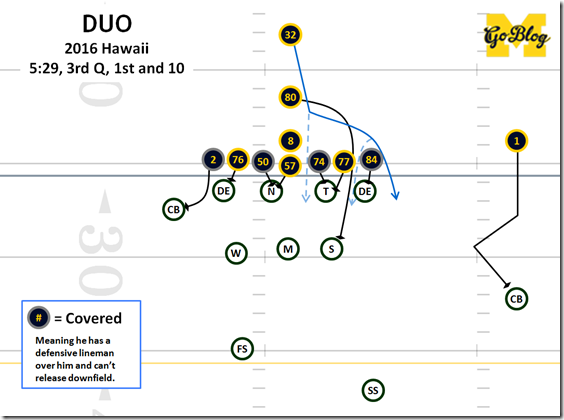
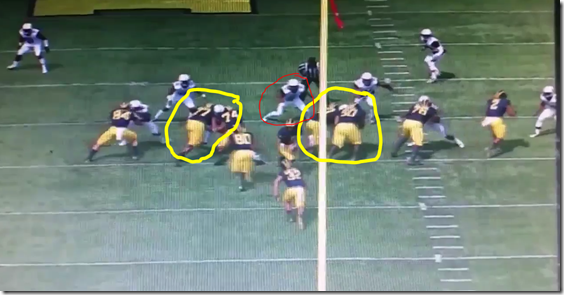


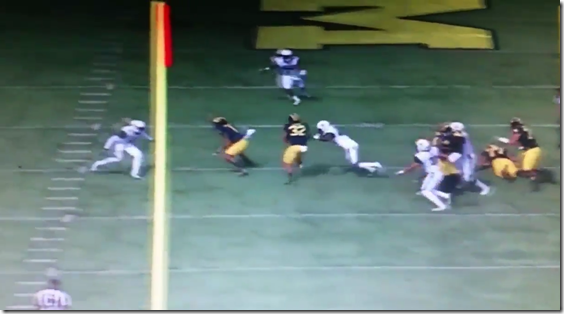
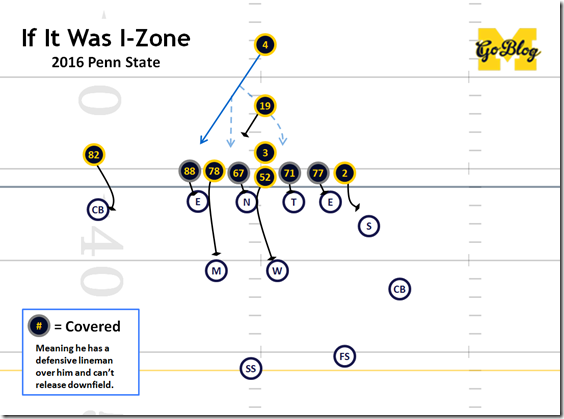
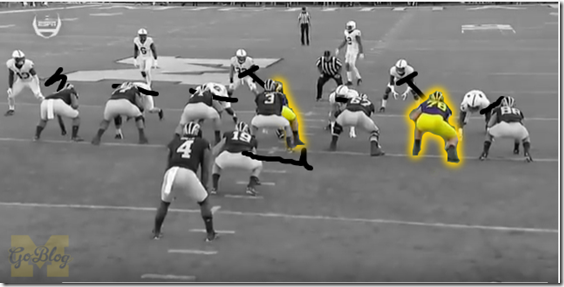
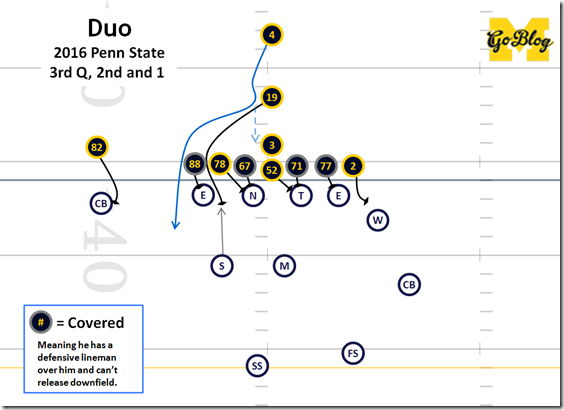


![image[91] image[91]](http://mgoblog.com/sites/mgoblog.com/files/image%5B91%5D_thumb.png)
